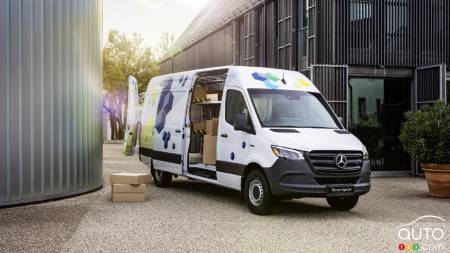• Mercedes-Benz will offer the all-electric eSprinter in North America.
• The model's maximum range could be as much as 350 to 400 km in city driving.
• Payload and towing capacity are reduced by more than 50 percent with the electric version.
The Sprinter is well known in Canada. The van has set the standard for commercial vehicles and led other manufacturers to adopt its formula. In Europe, Mercedes-Benz sells an electric version of its product, but the eSprinter has not been marketed in North America.
That's about to change. The all-electric eSprinter has just undergone significant upgrades, including an increase in its range. This will make it more interesting for our market. The model is scheduled to cross the Atlantic in the second half of this year.
It will also be built in North America, in Charleston, South Carolina.
The model does not change aesthetically. The formula is tried and true and keeping it the same means that costs can remain the same, whether it's for the purchase or for any repairs that need to be done.
The most significant and noticeable changes are out of sight. The company has actually divided the powertrain into three modules. The front section includes the high-voltage components, the middle the underfloor mounted battery pack, and the third the electric motor, axles and related components. This approach makes the eSprinter a modular vehicle, allowing for more flexibility. The company can install different battery packs without having to design different chassis for each one, thus reducing production costs.
Browse cars for sale available near you

In North America, the electric version of the Sprinter will be offered with the largest possible battery pack, a 113-kWh lithium-iron-phosphate unit. The configuration features a rear-mounted motor. As for the range, it’s 400 km according to the test cycle used in Europe, which should translate here into some 325 km. In an urban environment, Mercedes-Benz claims that in Europe the EV can be driven 500 km between charging, a figure that could work out to 400 km here.
To be sure, this is calculated using a vehicle not loaded with cargo. Capacities will be reduced significantly and proportionally to the weight being carried. Nevertheless, the model will offer something relevant to companies.
And by placing the battery pack under the floor, nothing is lost in terms of space. The only loss is in payload and towing capacity. With the EV, those are 2624 and 3300 lb, respectively, far less than the 7429 and 7500 lb possible with the regular Sprinter. Note that the passenger version of the Sprinter is not offered in electric configuration at this time.
Initially, only one configuration will be available, the high-roof, long-wheelbase version. We'll have to see if Mercedes-Benz adds more variants of its eSprinter over time. It will also be interesting to see what conversion companies can do with the vehicle. We know that many choose the Sprinter in RV configuration to take on the road for vacation.





